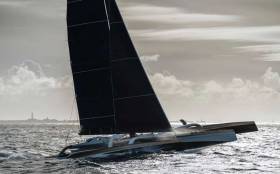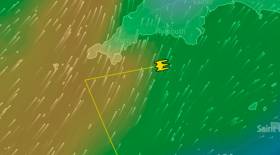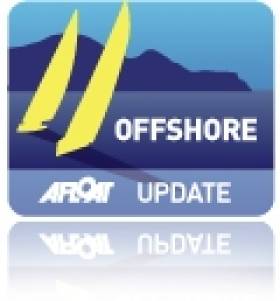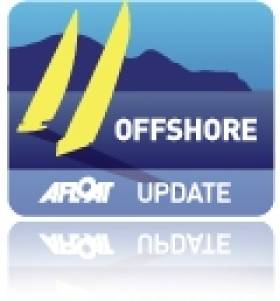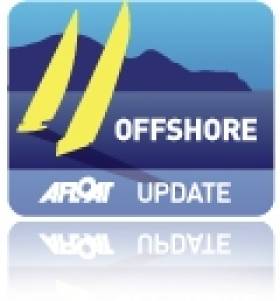Displaying items by tag: Spindrift 2
Spindrift Crossing the Doldrums
Yann Guichard and his 11 crew on the 40–metre trimaran Spindrift 2 are maintaining a record pace in their quest win the around the world Jules Verne Trophy. They have an advantage of 214.4 nm having covered 734.9 nm in the past 24 hours (as of 20:45 UTC).
They are currently just north of the equator and sailing at nearly 13 knots as they make the transition through the doldrums.
Tracker: www.spindrift-racing.com/jules-verne/en/live
See also Afloat.ie's Spindrift 2 North Sails competition and be in with a chance to win a North Sails Holdall here
Strong Winds Cancel Spindrift's Round Ireland Record Bid
The giant trimaran Spindrift 2 that was en route to Dun Laoghaire to start a Round Ireland Record attempt has had to scrub the bid due to strong winds off Lands End.
Afloat.ie reported earlier the trimaran was due to start her challenge from Dublin Bay early tomorrow.
Ireland's World Sailing speed commissioner Chris Moore, who is also Dublin Bay Sailing Commodore, confirmed the withdrawal of the French weekend challenge late tonight. 'Unfortunately the record attempt has been called off due to bad weather off Lands End, he told Afloat.ie
It is expected the 40–metre craft will head for the Solent where she will prepare for the Fastnet Race next month.
Giant Trimaran Crew Set Out On Jules Verne Trophy Round-the-World Record Bid
The Spindrift 2 sailing team confirm that they will leave in the next 24 hours to start their attempt on the Jules Verne Trophy round-the-world record.
After analysing the latest weather files this morning, Dona Bertarelli, Yann Guichard and their team confirmed a start from Ushant in the next 24 hours on their round-the-world record attempt for the Jules Verne Trophy (the time to beat: 45 days, 13 hours 42 minutes and 53 seconds). The wind is currently blowing at over 120 km/hour (75mph) at Pointe Bretagne with 5-metre waves. The skipper and the routing experts are now refining when the team will cast off from Brest (Malbert’s quay), but the likelihood is that the trimaran will cross the startline tonight.
Yann Guichard: “This is a good window and we can’t let it pass. We’ve decided to leave Brest in the next few hours with a start on the round-the-world imminent sometime in the night from Saturday to Sunday. The North Atlantic descent will be fast – around five days to the equator. The conditions in the Bay of Biscay and during the first 36 hours will be really difficult. It’s going to make it fast downwind and that’s what we were looking for.”
Dona Bertarelli: “We went to code green after seeing the latest weather file this morning, with a start tonight in tough conditions. We'll have to look after body and boat. There are still some uncertainties in the South Atlantic, where the weather models differ slightly, but we’re seizing our chance because we can’t ignore a window like this.”
THE JULES VERNE TROPHY:
Start and finish: a line between Créac’h lighthouse (Ushant island) and Lizard Point (England)
Course: non-stop around-the-world tour travelling without outside assistance via the three capes (Good Hope, Leeuwin and Horn)
Minimum distance: 21,600 nautical miles (40,000 kilometres)
Ratification: World Sailing Speed Record Council, www.sailspeedrecords.com
Time to beat: 45 days, 13 hours, 42 minutes and 53 seconds
Average speed: 19.75 knots
Date of current record: January 2012
Holder: Banque Populaire V, Loïck Peyron and a 13-man crew
Stand-by start date for Spindrift 2: October 19th, 2015
SPINDRIFT 2 CREW:
Yann Guichard, skipper
Dona Bertarelli, helmsman-trimmer
Sébastien Audigane, helmsman-trimmer
Antoine Carraz, helmsman-trimmer
Thierry Duprey du Vorsent, helmsman-trimmer
Christophe Espagnon, helmsman-bowman
Jacques Guichard, helmsman-trimmer
Erwan Israël, navigator
Loïc Le Mignon, helmsman-trimmer
Sébastien Marsset, bowman
François Morvan, helmsman-trimmer
Xavier Revil, helmsman-trimmer
Yann Riou, onboard reporter
Thomas Rouxel, helmsman-bowman
Jean-Yves Bernot, onshore router
Spindrift 2 Smashes Discovery Route Record
#WorldRecord - Six days, 14 hours, 29 minutes and 21 seconds: that's the new time to beat after the crew of Spindrift 2 smashed the previous Discovery route record by more than 20 hours.
The world's largest racing trimaran crossed the finish line at San Salvador in the Bahamas in the early hours of yesterday morning (6 November) after a blisteringly fast Atlantic crossing from Cadiz in Spain.
Reaching speeds of up to 46.08 knots and covering more than 714 miles last Friday 1 November alone, it was expected that the vessel skippered by Dona Bertarelli and Yann Guichard would make an impact.
But even rough seas and technical mishaps going into the final stretch didn't put much of a dent in their incredible margin, almost a full day ahead of the time set by previous record holder Groupama 3 in 2007.
And this amazing achievement will surely erase memories of Spindrift's woes in Dublin Bay over the summer.
"This is huge," said Bertarelli after confirmation of their record. "The emotion was waiting for us the moment we crossed the line. I enjoyed this race a lot; my first crossing of the Atlantic, in a race, for a record, with a good result at the end.
"Any doubts I might have had about this boat have gone. It is an extraordinary machine, and was combined with a great crew, following superb preparation made by the team on the ground and a sound choice of route."
Spindrift 2 Enters Final Stretch Of Atlantic Record Attempt
#WorldRecord - Now on day six of their Discovery route record attempt, Dona Bertarelli and Yann Guichard's Spindrift 2 is on the home stretch as the aim to reach the Bahamas in the early hours of tomorrow morning (6 November).
After setting out from Cadiz in Spain last Thursday 31 October, the world's largest racing trimaran experienced her first major difficulties of the transatlantic challenge over the past 24 hours, losing significant pace in rough seas between two violent squalls and seeing her first mechanical failure of the voyage, though that was quickly resolved.
The boat managed an average of just 14.5 knots overnight to advance 175 miles, seeing their lead on the current record holder slip by 60 miles in a single day.
But co-skippers Bertarelli and Guichard and their experienced crew put so many miles in the bag earlier in the week that they still have a massive 270-mile lead on the old record, set in May 2007 - now an age away in terms of boat development.
And with a strong northerly breeze coming down the North American coastline towards the Bahamas, the last 600 miles of the race should see Spindrift 2 show her fullest potential as the 'F1 of the seas'.
"This last phase of the course looks like is going to be tough," admits Bertarelli, noting storms on the radar at the finish line, but Spindrift 2 "is a beast of a machine, her strength in the strong wind is phenomenal."
Spindrift 2 On Standby For Discovery Route Record Attempt
#WorldRecord - The world's largest racing trimaran is on standby awaiting the right weather window to launch their attempt at the Discovery route world record.
Spindrift 2 - the successor to the trimaran skippred by Yann Guichard that met an unfortunate fate in Dun Laoghaire this summer - has been in Portimao in Portugal since 7 October waiting for the perfect conditions to mount their challenge on the Discovery route from Cadiz in southwestern Spain to San Salvador in the Bahamas.
The record for the near 4,000 nautical mile transatlantic route is currently held by Groupama 3, a Franck Cammass-skippered vessel that's part of the same team that won the Volvo Ocean Race in Galway in 2012.
Groupama 3 set a record time of seven days, 10 hours, 58 minutes and 53 seconds with an average speed of 21.7 knots in May 2007, beating the previous time set by Steve Fossett's PlayStation by almost two whole days.
Meanwhile, Guichard and co-skipper Dona Bertarelli, last seen in action in the Rolex Fastnet Race, will be waiting for the trade winds to pick up pace and the Azores high pressure system into place creating the optimum conditions to set out from Cadiz.
"Once we have rounded the Canary Islands by the right it will be a matter of fine tuning our strategy and choosing the best possible course to join San Salvador," saus Guichard.
"The options are a more northerly course, closer to the direct route, or a more southerly course, further off the direct course but presenting better conditions."
Follow the team on Twitter @spindriftracing for the latest Discovery route news.


























